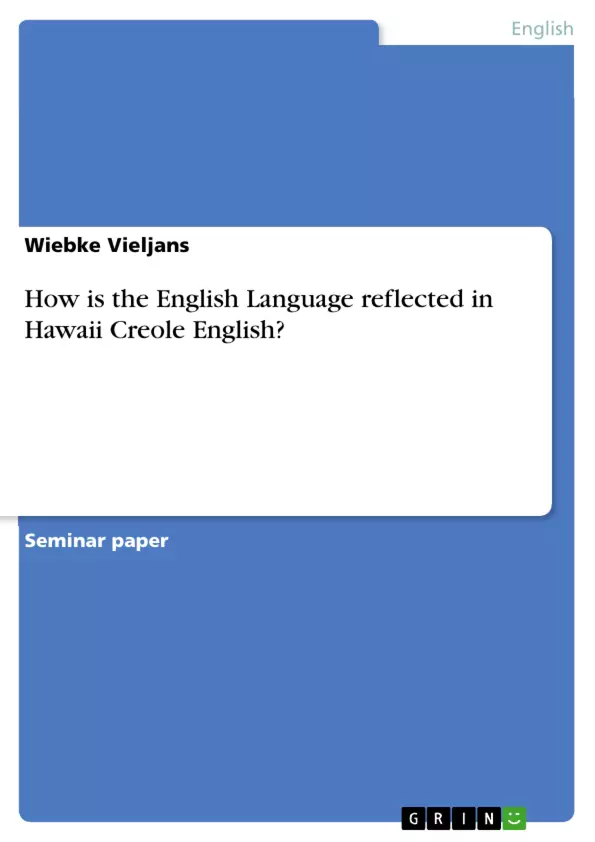“Pidgins and Creoles are not full or real languages.”
Pidgins and Creoles seem to have negative connotations. Like Mühlhäusler argues in his abstract, the history of examining pidgin and creole languages can be seen as a consequence of this view. “Rather they are broken English/French (the popular view), marginal languages (Reineke), ‘Ludersprachen’ (prostitute languages - an expression used by Nazi linguists), parasitic systems (Chomsky).”2Nowadays, this opinion Mühlhäusler criticized is nevertheless disproved and antiquated. TheEncyclopaedia Britannicaonce described Pidgin English as “an unruly bastard jargon, filled with nursery imbecilities, vulgarisms and corruptions”.3But it no longer uses such a definition. Recently, for example scholars recall that pidgins mirror human creative linguistic ability.4
Now this course work should deal with Hawaii Creole English, starting with a short definition of pidgin and creole languages and then turning to some background information about the Hawaiian Islands, which is quite important to understand the context of language developments. Afterwards, Hawaii Creole English5is examined with regard to consonants, vowels, intonation as well as phonology, grammar, semantics and pragmatics. Furthermore, it is compared with Hawaiian, the original language of Hawaii, and Hawaii Pidgin English. As a conclusion, one could summarize the use of studying pidgin and creole language with the help of a few new aspects, and briefly discuss the feature of decreolization in Hawaii, if there is some. The aim of this course work should be to evaluate the sociolinguistic approach of Hawaii with the linguistic facts of HCE, noting also the expansion of the language.
Table of Contents
- Introduction
- Background information about the Hawaiian Islands
- Hawaii Creole English
- Consonants
- Vowels
- Intonation and Phonology
- Grammatical Features
- Semantics and Pragmatics
- Hawaiian vs. Hawaii Pidgin English vs. Hawaii Creole English
- Conclusion
Objectives and Key Themes
This course work explores Hawaii Creole English (HCE), beginning with definitions of pidgin and creole languages and then moving to the historical context of language development in the Hawaiian Islands. The paper examines the phonology, grammar, semantics, and pragmatics of HCE, comparing it with Hawaiian and Hawaii Pidgin English. It concludes with a discussion of the sociolinguistic approach to HCE and its expansion.
- The origins and development of pidgin and creole languages
- The historical and social context of language change in the Hawaiian Islands
- The linguistic features of Hawaii Creole English
- The relationship between HCE, Hawaiian, and Hawaii Pidgin English
- The sociolinguistic aspects of HCE and its expansion
Chapter Summaries
The introduction sets the stage by addressing common misconceptions surrounding pidgin and creole languages, highlighting their historical mischaracterization as "broken" or "marginal" languages. The paper asserts the importance of studying these languages, emphasizing their linguistic richness and complexity.
The chapter on background information about the Hawaiian Islands delves into the historical context of the development of HCE. It examines the arrival of Europeans, the establishment of sugarcane plantations, and the influx of laborers from various countries, leading to the mixing of populations and the need for a common language.
The chapter on Hawaii Creole English focuses on the linguistic features of this language, exploring its phonology, grammar, semantics, and pragmatics. The chapter analyzes the unique characteristics of HCE, showcasing its distinct features and highlighting its evolution from earlier pidgin forms.
The chapter on the comparison of Hawaiian, Hawaii Pidgin English, and HCE analyzes the relationships between these languages, providing a comprehensive understanding of their shared and distinct elements. The chapter sheds light on the evolution of HCE from its earlier forms and the linguistic influences that shaped its development.
Keywords
The paper focuses on Hawaii Creole English, pidgin and creole languages, language contact, linguistic change, sociolinguistics, language expansion, the Hawaiian Islands, and the historical and social context of language development.
- Arbeit zitieren
- Wiebke Vieljans (Autor:in), 2004, How is the English Language reflected in Hawaii Creole English?, München, GRIN Verlag, https://www.grin.com/document/62534



